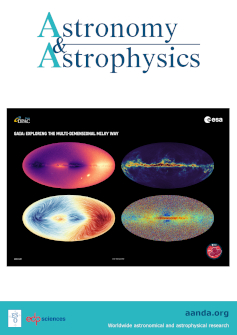RS CVn型恒星II Peg外部大气中与耀斑有关的等离子体运动
IF 5.4
2区 物理与天体物理
Q1 ASTRONOMY & ASTROPHYSICS
引用次数: 0
摘要
与太阳耀斑类似,恒星耀斑是大气层中的剧烈爆炸,可能伴随着突出喷发、日冕物质抛射(CME)和其他形式的等离子体运动。基于对 RS CVn 型恒星 II Peg 的时间分辨光谱观测,我们旨在寻找与耀斑相关的潜在等离子体运动。在这些观测中,我们探测到了光学耀斑逐渐衰减阶段的一部分,我们发现其 Hα 线的能量下限为 6.03 × 1033 erg。将这个 Hα 能量换算后,我们发现螺栓白光能量为 3.10 × 1035 erg。此外,我们还观测到一个次峰值。移除静态参照物后,Hα残差显示出不对称的行为,包括蓝移和红移发射成分。前者的主体速度约为-180 km s-1,并延伸到-350 km s-1以上。这种现象很可能是由突出喷发事件或色球蒸发过程引起的。后一种发射成分的体积速度为 130-70 km s-1,并将其速度扩展到近 400 km s-1。我们将红移发射成分归因于几种可能情况中的一种或几种组合:耀斑驱动的日冕雨、色球层冷凝、靠近恒星边缘的后向突出喷发或突出喷发中的物质坠落。据估计,产生蓝移和红移发射成分的移动等离子体的最小质量分别为 0.56 × 1020 g 和 1.74 × 1020 g。本文章由计算机程序翻译,如有差异,请以英文原文为准。
Flare-related plasma motions in the outer atmosphere of the RS CVn-type star II Peg
Analogous to solar flares, stellar flares are dramatic explosions in the atmosphere, which may be accompanied by prominence eruptions, coronal mass ejections (CMEs), and other forms of plasma motion. Based on time-resolved spectroscopic observations of the RS CVn-type star II Peg, we aim to search for the potential plasma motions associated with flares. In these observations, we detected part of the gradual decay phase of an optical flare, for which we find a lower limit on the energy of the Hα line of 6.03 × 1033 erg. Converting this Hα energy, we find a bolometric white-light energy of 3.10 × 1035 erg. Moreover, a secondary peak is also observed. After removing a quiescence reference, the Hα residual shows an asymmetric behavior, including both a blueshifted and a redshifted emission component. The former component has a bulk velocity of about −180 km s−1 and extends its velocity to more than −350 km s−1. This phenomenon is likely caused by a prominence eruption event or a chromospheric evaporation process. The latter emission component has a bulk velocity of 130–70 km s−1 and extends its velocity to nearly 400 km s−1. We attribute the redshifted emission component to one or a combination of several possible scenarios: flare-driven coronal rain, chromospheric condensation, backward-directed prominence eruption close to the stellar limb, or falling material in a prominence eruption. The minimum masses of the moving plasmas resulting in the blueshifted and redshifted emission components are estimated to be 0.56 × 1020 g and 1.74 × 1020 g, respectively.
求助全文
通过发布文献求助,成功后即可免费获取论文全文。
去求助
来源期刊

Astronomy & Astrophysics
地学天文-天文与天体物理
CiteScore
10.20
自引率
27.70%
发文量
2105
审稿时长
1-2 weeks
期刊介绍:
Astronomy & Astrophysics is an international Journal that publishes papers on all aspects of astronomy and astrophysics (theoretical, observational, and instrumental) independently of the techniques used to obtain the results.
 求助内容:
求助内容: 应助结果提醒方式:
应助结果提醒方式:


